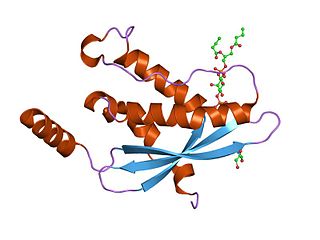
Phosphoinositide 3-kinases (PI3Ks), also called phosphatidylinositol 3-kinases, are a family of enzymes involved in cellular functions such as cell growth, proliferation, differentiation, motility, survival and intracellular trafficking, which in turn are involved in cancer.

Phosphatidylinositol 3-phosphate (PtdIns3P) is a phospholipid found in cell membranes that helps to recruit a range of proteins, many of which are involved in protein trafficking, to the membranes. It is the product of both the class II and III phosphoinositide 3-kinases activity on phosphatidylinositol.

Phosphatidylinositol (3,4)-bisphosphate is a minor phospholipid component of cell membranes, yet an important second messenger. The generation of PtdIns(3,4)P2 at the plasma membrane activates a number of important cell signaling pathways.

Sorting nexin-1 is a protein that in humans is encoded by the SNX1 gene. The protein encoded by this gene is a sorting nexin. SNX1 is a component of the retromer complex.

Neutrophil cytosol factor 2 is a protein that in humans is encoded by the NCF2 gene.

Neutrophil cytosol factor 1, also known as p47phox, is a protein that in humans is encoded by the NCF1 gene.

Neutrophil cytosol factor 4 is a protein that in humans is encoded by the NCF4 gene.

Sorting nexin-9 is a protein that in humans is encoded by the SNX9 gene.

Sorting nexin-17 is a protein that in humans is encoded by the SNX17 gene.

NADPH oxidase organizer 1 is an enzyme that in humans is encoded by the NOXO1 gene.

TC10/CDC42 GTPase-activating protein is an enzyme that in humans is encoded by the SNX26 gene.

Sorting nexin-3 is a protein that in humans is encoded by the SNX3 gene.

Sorting nexin-13 is a protein that in humans is encoded by the SNX13 gene.

Sorting nexin-15 is a protein that in humans is encoded by the SNX15 gene.

NADPH oxidase activator 1 is an enzyme that in humans is encoded by the NOXA1 gene.

Sorting nexin-4 is a protein that in humans is encoded by the SNX4 gene.

Sorting nexin-21 is a protein that in humans is encoded by the SNX21 gene.

Sorting nexin-18 is a protein that in humans is encoded by the SNX18 gene.

Sorting nexins are a large group of proteins that are localized in the cytoplasm and have the potential for membrane association either through their lipid-binding PX domain or through protein–protein interactions with membrane-associated protein complexes Some members of this family have been shown to facilitate protein sorting.

Sorting nexin 10 is a protein that in humans is encoded by the SNX10 gene.




















